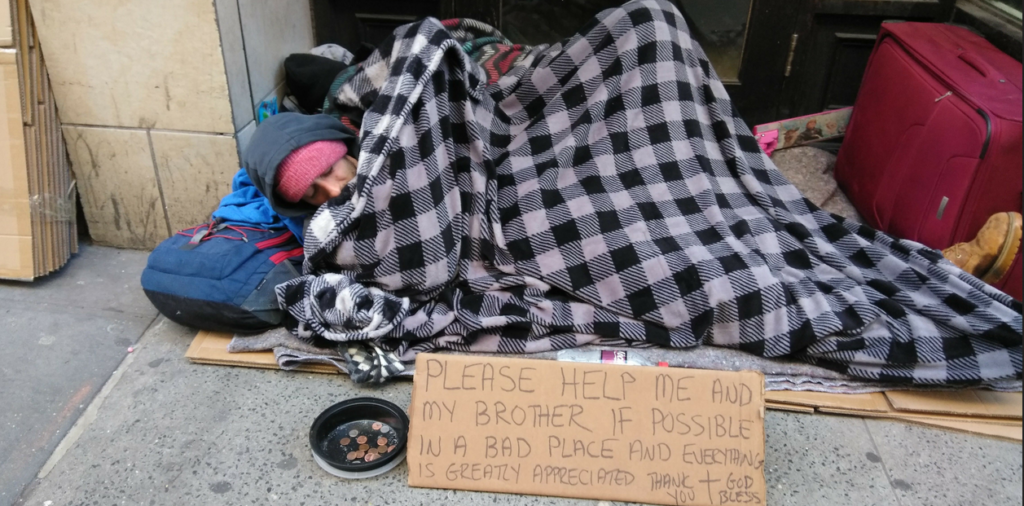By National Alliance To End Homelessness
Photos: Operation Better Days\Wikimedia Commons
December 27, 2024 — Washington, D.C. — The U.S. Department of Housing and Urban Development (HUD) Friday released its 2024 Annual Homelessness Assessment Report (AHAR) Part 1 to Congress, revealing an 18.1 percent increase in homelessness across the nation. The report, compiled from data gathered at a point in time in January 2024, underscores the growing urgency of the homelessness crisis, driven by a combination of longstanding affordable housing shortages, rising inflation, discrimination, and insufficient social safety nets to address the rising demand for support. Marginalized people, including people of color, continue to be over-represented in the data released today.

The biggest driver of the crisis is the widespread lack of affordable housing. In 2024, median rent was 18 percent higher than it was in 2020, and the National Low Income Housing Coalition estimates there is a shortage of 7.3 million units of affordable and available rental homes in the country.
One of the most harrowing data points from the report is that family homelessness rose by 39.4 percent. This is unacceptable and continues to demonstrate that the needs of the most vulnerable are not being met. This crisis drives people into homelessness every day in America and makes the work to rehouse them far more difficult.

While the data presents a challenging outlook, it demonstrates that success is possible when the federal government prioritizes evidence-based solutions and funds these resources to scale.
“The answer to ending homelessness is ensuring everyone has access to safe, stable, and affordable housing. Our leaders must immediately expand the resources to rehouse people without homes and assist the rapidly growing number of people who cannot afford skyrocketing rents,” said Ann Oliva, CEO of the National Alliance to End Homelessness. “This record-setting increase in homelessness should sound the alarm for federal, state, and local lawmakers to advance evidence-based solutions to this crisis.”
One notable example is the reduction in veteran homelessness. From January 2023 to January 2024, veteran homelessness dropped by 7.6 percent, with unsheltered veteran homelessness seeing a 10.7 percent decrease. This marks the continuation of a successful federal strategy that has reduced veteran homelessness by more than 55 percent since 2010, making it one of the most significant achievements in the fight to end homelessness in America.
The success in reducing veteran homelessness is proof further investments must be made to have enough resources to help all populations.

“The reduction in veteran homelessness offers us a clear roadmap for addressing homelessness on a larger scale,” said Oliva. “With bipartisan support, adequate funding, and smart policy solutions, we can replicate this success and reduce homelessness nationwide. Federal investments are critical in tackling the country’s housing affordability crisis and ensuring that every American has access to safe, stable housing.”
Federal intervention is needed to ensure that this crisis does not worsen. Key findings from the HUD 2024 AHAR report reveal several systemic challenges that may impact rising homelessness.
- Housing Affordability: The country continues to face a severe shortage of affordable housing, exacerbated by inadequate federal intervention. Without comprehensive systems to prevent homelessness and transition individuals into permanent housing, many Americans remain trapped in the cycle of homelessness.
- Insufficient Social Safety Nets: Federal programs like the Housing Choice Voucher program (also known as Section 8) are underfunded, currently able to assist only one in four eligible households. As pandemic-era rental assistance programs expire, many households are left without critical resources to maintain housing stability.
- Lack of Preventive Systems: Too few systems are in place to identify people at imminent risk of homelessness and intervene before they become unhoused. The systems that serve people at imminent risk of homelessness, including housing, healthcare, criminal justice, and education, often fail to coordinate and provide timely support to prevent loss of housing.
- Racial Disparities: Homelessness continues to disproportionately impact people of color and marginalized communities, due to both historic and modern discrimination in housing, employment, wages, healthcare, and economic opportunity.

Despite challenges, these key strategies to combat homelessness are working in several communities that reported reductions:
- Expanded Shelter and Services: Communities are making strides in expanding shelter capacity, though services remain underfunded and difficult to access for many.
- Innovative Funding Models: Successful communities are leveraging state and local funds to supplement federal resources and support new approaches to homelessness prevention and housing stability. They are also creatively leveraging Medicaid funds to pay for housing services.
- Collaborative Efforts: Partnerships with a range of sectors, from landlords to local courts, are proving effective in addressing homelessness at multiple levels. Effective partnerships with Public Housing Authorities are creating particularly strong opportunities to utilize targeted vouchers and rapidly rehouse people.
- Diversion: Innovative diversion models are helping people at imminent risk of homelessness secure the resources they need to stay housed and avoid ever having to enter homelessness systems in the first place.
HUD’s 2024 AHAR Part 1 report serves as a stark reminder of the need for continued, targeted action. The federal government has an essential role in providing the resources needed to reduce homelessness and address the underlying housing affordability crisis. With sustained investment and collaboration, the country can make significant progress in ensuring that all individuals and families have a place to call home.
The Alliance will continue to release further analysis of the AHAR Part 1 in the coming weeks.
Subscribe to our newsletter for the latest information: https://endhomelessness.org/

About the National Alliance to End Homelessness
The National Alliance to End Homelessness is a nonprofit, non-partisan, organization committed to preventing and ending homelessness in the United States. As a leading voice on the issue of homelessness, the Alliance analyzes policy and develops pragmatic, cost-effective policy solutions; works collaboratively with the public, private, and nonprofit sectors to build state and local capacity; and provides data and research to policymakers and elected officials in order to inform policy debates and educate the public and opinion leaders nationwide.






